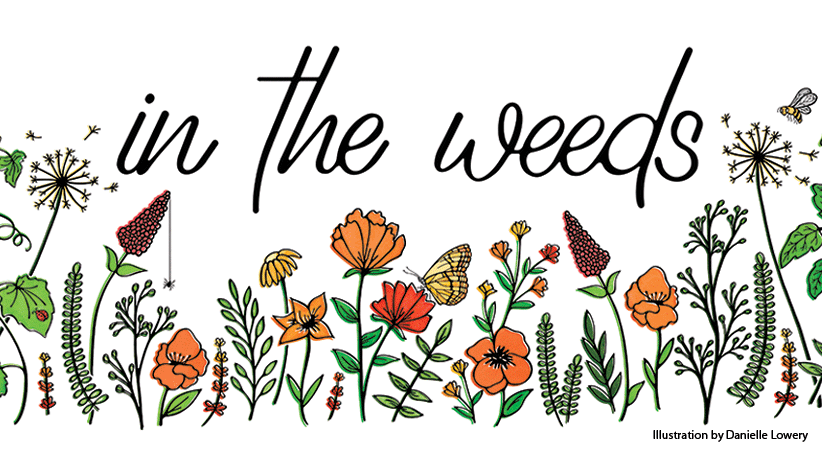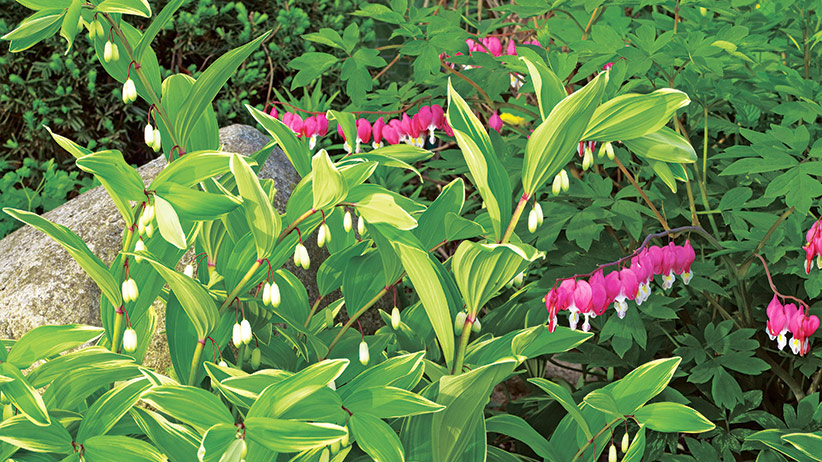Showstopping front yard garden
Like many of us, Renee Minirth’s Memphis garden started with a few pass-along plants several years ago: Three English rose cuttings from her father-in-law. These few plants ignited Renee’s interest in gardening. Fast forward to 2015 when Renee’s family moved into their second house (and brought the roses), and her hobby blossomed. Renee decided to mostly start over on the front-yard garden because it appeared that drought and disease had taken their toll on the once-beautiful boxwoods and azaleas. She replanted the foundation plantings with new boxwoods (Buxus spp. and hybrids) and yews (Taxus spp. and hybrids), but every trip to the garden center revealed new plants that she wanted to try.
And then the pandemic hit. Renee, a forensic psychiatrist, was working long, difficult hours and found herself spending the rest of her time at home. “I poured myself into the garden as a means of coping. Garden is my exercise, my mental relief and my art form,” she says. Take a video tour above and keep reading to learn more about her front yard garden's transformation.
You Might Also Like:
Create a Beautiful Rose Garden
The Best Plants for Foundation Plantings
Watch More Talk & Tour Videos on YouTube
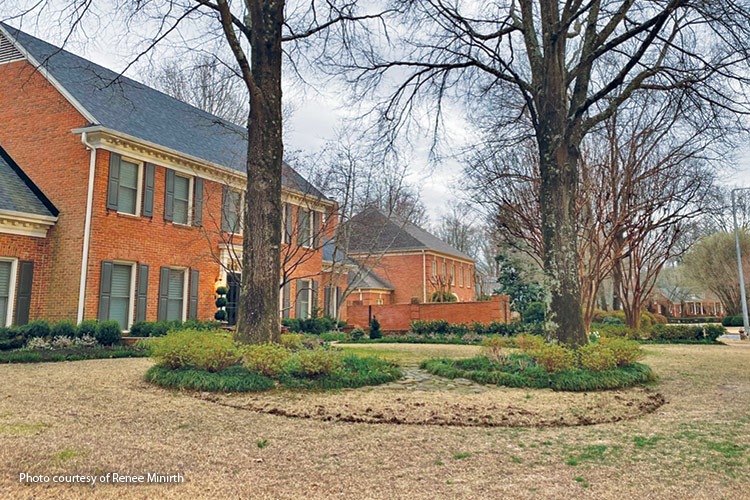
Starting the front yard garden
In spring 2021, Renee decided to expand the beds in the front yard. You can see the original pin oaks with small circles of ground cover and several lanky azaleas beneath them in the before photo above. Renee played around with the idea of two islands but realized that this just wouldn’t be enough room for all of the plants that she had in mind. So in the end, she drew up a large kidney-shaped bed with a pathway through the middle that joined the two trees together.

Start with structure
She cut back the old azaleas to rejuvenate them, then once another local gardener helped her identify them as ‘Girard’s Pleasant White’, she added several more of that variety in a semicircle. Other shrubs snake through the bed in curving rows to give it background and structure. They include Sprinter® littleleaf boxwood (Buxus microphylla), ‘Otto Luyken’ dwarf cherry laurel (Prunus laurocerasus) and Ivory Halo Tatarian dogwood (Cornus alba). She bridged the gap between the tall pin oaks (Quercus palustris) and lower-growing shrubs with ‘Appalachian Spring’ flowering dogwood (Cornus florida), which was bred at the University of Tennessee and is well suited to the climate in this Memphis garden.
Planting around a tree
If you’ve ever tried to plant a garden around an existing tree, you know that your first goal is to keep the established tree healthy. That’s why Renee was careful not to damage any large roots when she dug holes for the shrubs. Luckily, oak trees tend to have fewer surface roots than some, so it’s easier than it might have been under a different type of tree.

Add colorful plants
Once Renee had the shape and structure of this front yard put together, she planted a combination of bulbs, annuals and perennials to keep a colorful show going from early spring through fall in this front yard garden. It starts with tulips, and by summer, when the trees are all leafed out, she replaces them with shade-loving annuals, such as impatiens and coleus, and the colorful caladiums in the photo above. She’s able to dig up and save about a third of the caladiums from year to year, but others fade away and need to be replaced. The impact they make in this highly visible spot makes it worth the work.
You Might Also Like:
Best Shade Plants for Your Garden
Colorful Coleus Plant Combinations
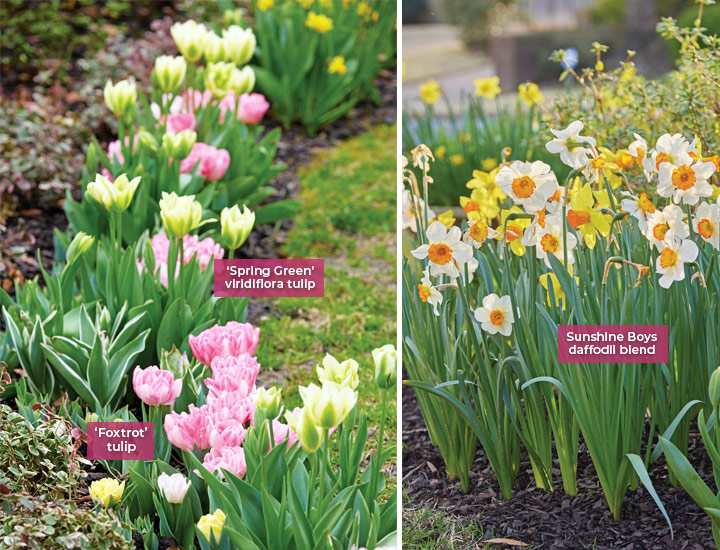
Spring curb appeal for a front yard garden
This front yard garden has plenty to look at all year, but its spring show is especially impressive. Renee says that she planted 4,600 spring-blooming bulbs, including tulips and daffodils (Narcissus hybrids), a couple of years ago. You can see the results of that hard work on these pages. She doesn’t plant that many every year, as many return.
If you’re planting in open bed space, the easiest way to plant large numbers of bulbs is to dig a trench in fall, drop in the bulbs and shovel soil over them. Put a mix of early, mid- and late-blooming varieties in the same trench and you’ll guarantee color for several weeks, or even months. Renee says that she gets the longest show out of early and midseason varieties because by the time the late tulips bloom, the weather is turning hot, which causes the flowers to fade faster. Trenching isn’t an option for every spot in this garden, so in the spaces between companion perennials, Renee digs bulbs in individually.
A few spring favorites for this front yard
Pink and blue are Renee’s favorite flower colors, so she starts with those two base colors, and usually adds accents of white and yellow. The pink tulips include early ‘Foxtrot’ and ‘Spring Green’ seen above, midseason white-tinged-with-pink ‘Infinity’ and late-blooming ‘Sauternes’. The cheerful Sunshine Boys™ daffodil blend in the photo above at right is a terrific way to start the season, and fragrant white ‘Thalia’ daffodils are a favorite in midspring. Long-lasting blue, pink and white windflowers (Anemone coronaria) have multiplied beautifully along the borders. Finally, every year Renee likes to try some new surprises. This year she loved ‘Black Hero’ tulips, so they may make it into the regular rotation as well.
You Might Also Like:
Linda Vater's Spectacular Spring Tulip Garden
Spring-Flowering Bulbs
6 Ways to Create a Beautiful Spring Garden
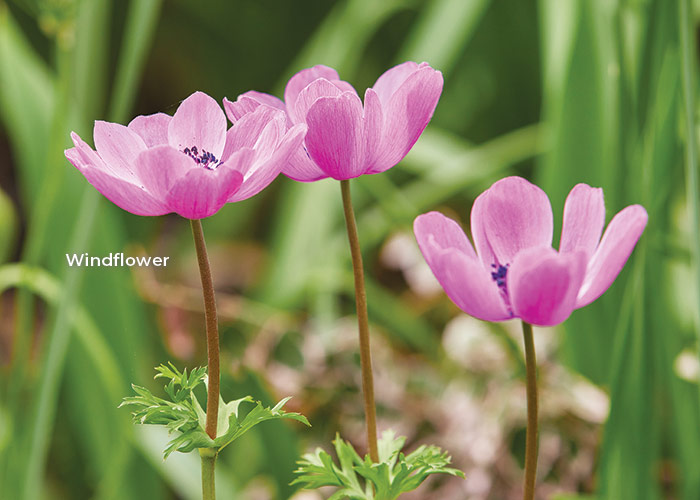
Invest in plants that multiply
Daffodils and windflowers return reliably and, in fact, multiply. While Renee doesn’t pull and replace the tulips, she also can’t count on them to return, so she adds more each fall to guarantee blooms, as they tend to fade out after a few years — and often get eaten by her nemesis, voles. Read on to learn how she deals with that problem in her garden.
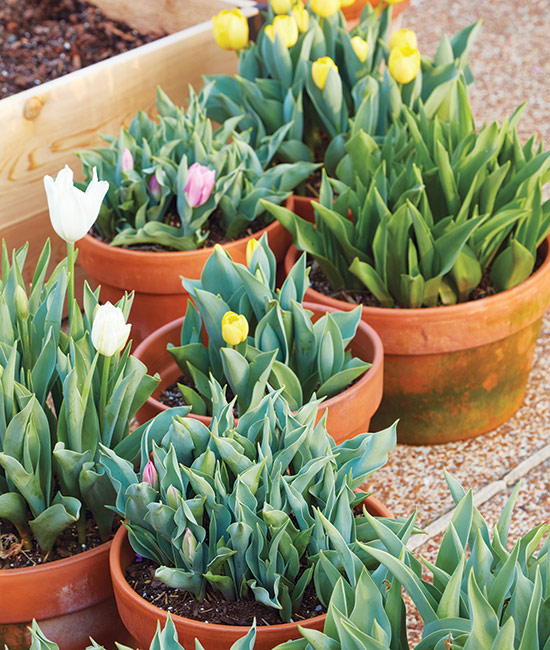
Try tulips in containers
Tulips also make beautiful container plants. Renee keeps several simple pots tucked in an out-of-the-way place all winter, and as each pot is about to burst into bloom, it’s ready to move to a spot on the patio or next to the front door. Another perfect use? Plant tulip bulbs in your vegetable beds and use them as cut flowers before you need the space for other plants later.
You Might Also Like:
Easy Spring Containers
Favorite Tulips to Grow
Container Garden Inspiration
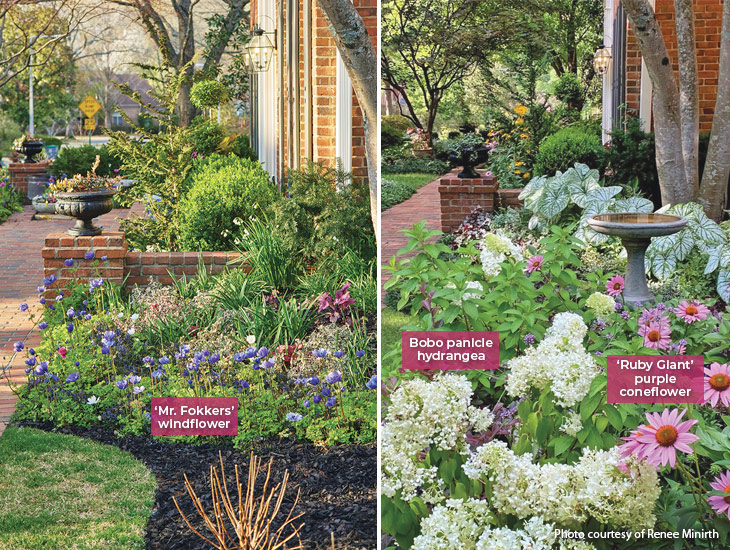
Multiseason front yard garden
The mix of plants in this front yard garden ensures that there’s something beautiful to look at year-round. In spring it’s the bulbs and early emerging plants beneath still-leafless trees in the photo on the left above. The structure of the repeated shrubs make a great backdrop, and by late spring, they have come into their own, as you can see in teh photo above at right. Some favorite perennials in this shady front yard include coral bells (Heuchera spp. and hybrids), hostas (Hosta spp. and hybrids), coneflowers (Echinacea purpurea) and toad lilies (Tricyrtis spp. and hybrids), which bloom in late summer or fall. By summer, the panicle hydrangeas (Hydrangea paniculata) have reached their glory and make a big impact in that spot as well. What a welcome!
Weather-based garden challenges
Gardening in Memphis definitely presents its challenges. There’s usually plenty of rainfall (although 2022 was an especially dry year), so Renee doesn’t irrigate very often, but lots of moisture paired with the characteristic Tennessee heat creates a different problem: fungal diseases. The few roses she grows in the backyard are especially susceptible to blackspot. But she doesn’t want to give up on them; they were her first plants, after all. So she starts spraying them with a copper fungicide in late winter, which helps, but by midsummer many have succumbed, so she leaves them alone and the following spring they re-emerge with fresh foliage.
How to deal with voles in the garden
These little rodents eat bulbs, tunnel in the lawn and chew up perennial and shrub roots. However, Renee takes a big-picture approach: “I prefer to live with them and work with the natural order of things, so I encourage natural predators like owls and the two hawk families that live in the yard.” She refuses to use poison to kill the critters because she doesn’t want to hurt the birds. So she tries to live with the damage and protects the plants that they seem to hurt most: She often plants new hydrangeas in wire mesh baskets to protect the roots. But that isn’t a realistic solution for hundreds of bulbs. She’s discovered that a 12-inch-deep trench filled with sharp lava rock installed around bed edges seems to deter them, so she puts this in spots that are especially hard hit.
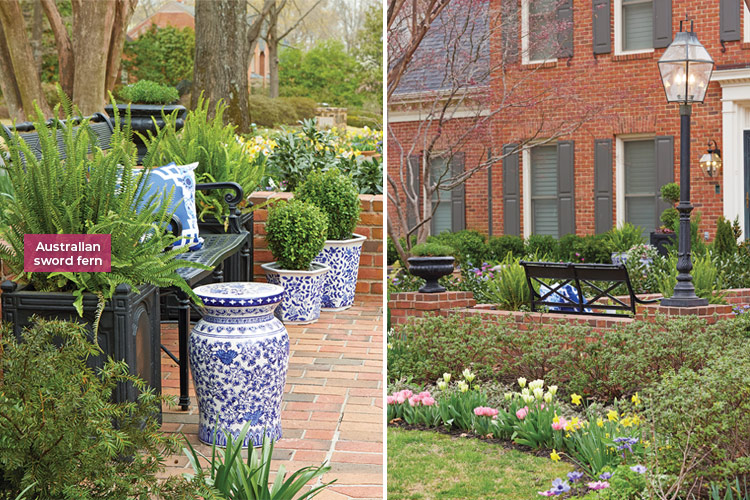
Add classic hardscaping
Plants aren’t the only thing that makes this front yard garden so appealing. Brick walls, paths and pedestals add both repetition and punctuation to the design and create an alcove around the seating area in the photos above. Classic wrought-iron furniture and urns blend in perfectly with the traditional brick hardscaping and crisp edges in the rest of this front yard.
Renee enjoys her morning coffee here, and it’s one of three benches tucked into different spots around the front yard, all offering unique views and a surprising amount of privacy. Renee calls the lamp next to this bench her “Narnia lamp.” It’s the perfect entrance to her magical garden escape.
You Might Also Like:
How to Add Structure to Your Garden
Tour this Charming Southern Backyard










